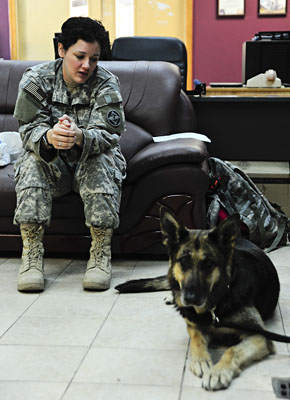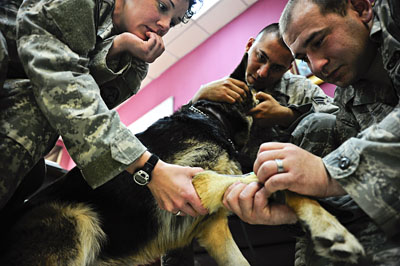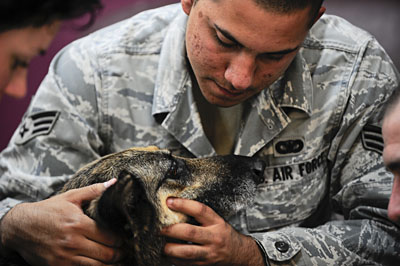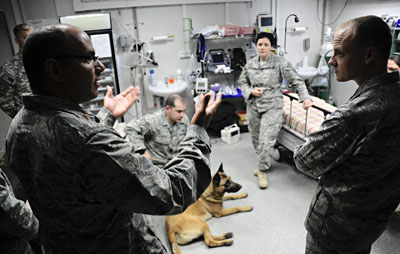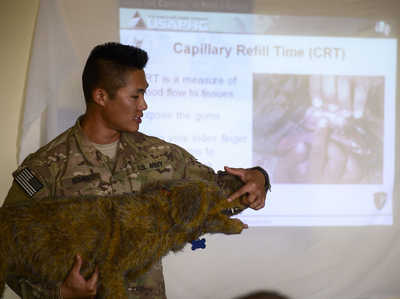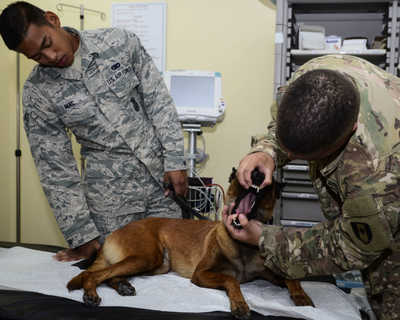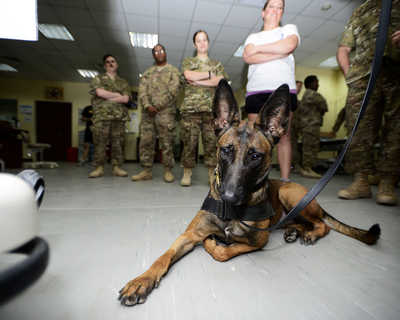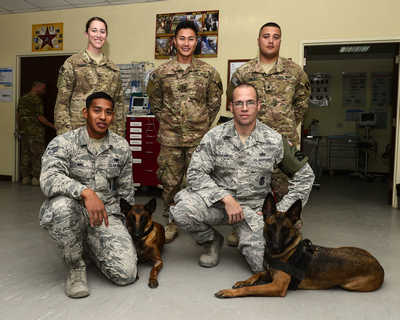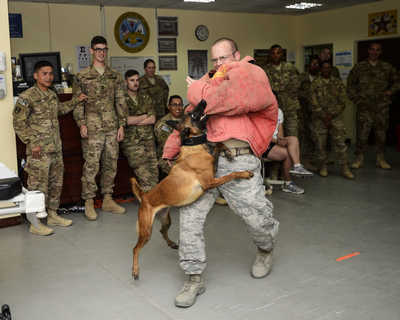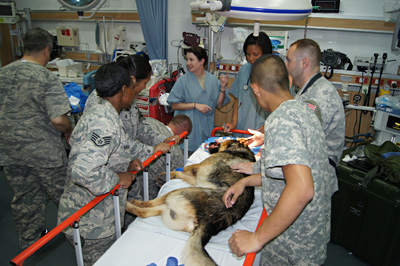
General Medical Care
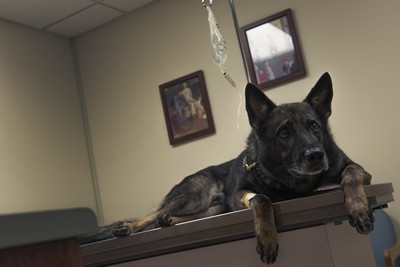
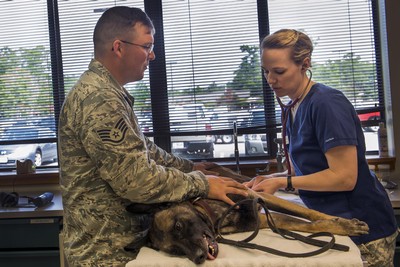
Vet clinic supports MWD program with care, training
7/22/15 - MOODY AIR FORCE BASE, Ga. (AFNS) -- Military working dogs require extensive medical care to keep their noses in good working condition to help sniff out drugs and explosives and aid in base security.
To ensure these canines are up for the task, the 23rd Aerospace Medicine Squadron Veterinary Services Flight supports Moody's MWDs by maintaining their preventative care.
"Our primary mission is to provide medical care for the military working dogs," said Army Capt. (Dr.) Allison Brekke, the 23rd AMDS officer in charge of veterinary services. "We maintain their preventative care through vaccinations, parasite control and general wellness screenings to keep them fit to fight.
"We also run a vet clinic on base as a means to keep up our medical skills, so we can continue to provide care to the working dogs," she added.
The MWD handlers interact with the vet clinic regularly for checkups and to receive medical training for their companions.
"We conduct, at a minimum, quarterly training (with the MWD handlers)," Brekke said. "The working dogs are like any other animal and cannot be operated on for training purposes ... but when they come in for their procedures, we try to get the handlers engaged with the medical processes."
Within austere environments like a deployed location there might not be a veterinarian available, so the MWD handlers may need to provide medical care to their K-9s to help save its life.
"In the field, we need to have the ability to recognize when our (working dog) isn't feeling right," said Staff Sgt. Nicholas Bonello, a 23rd Security Forces Squadron MWD trainer. "Having the training to identify what is wrong with our working dogs can be the difference in saving their life."
Even if the dog makes it through unscathed, the aftermath of a deployment can take a toll on them. As a precaution, the clinic checks the canines for post-traumatic stress disorder upon their return.
"PTSD is very common in working dogs," Brekke said. "We screen for it post-deployment and have training for recovery. If we observe any signs of PTSD, we consult with a behaviorist to get them the help they need."
If an emergency occurs with MWDs, like a PTSD panic attack, the clinic's Army technicians remain on call to provide them immediate care when necessary.
"What is asked of my technicians is far beyond what you'd expect from their job," Brekke said. "They're fully committed to the job, not because of the pay and benefits, but because they care about the dogs as much as I do."
Even through long hours to ensure the dog's operational health, the technicians continue to help the MWD handlers keep the dogs smiling, according to Brekke.
"We have a really friendly working dog population (here)," Brekke said. "I think that comes from the handlers and kennel masters dictating their kennel environment and care."
MWD handlers and their canines oftentimes build strong bonds of companionship, and for Bonello, trusting someone with his canine is a big deal.
"We definitely have a good working relationship with (the vet clinic here)," Bonello said. "I trust them with my dog because they're who we look for when we need help."
Read Original Article
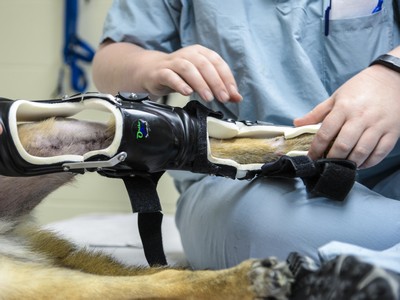
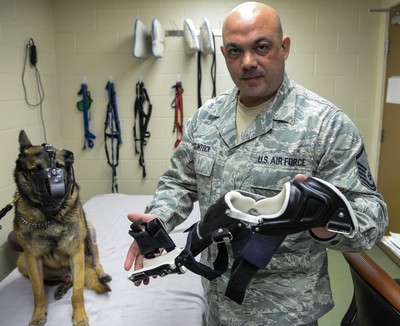
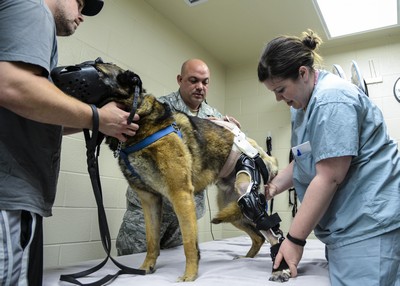
Orthotic tech helps military working dog walk again
4/22/15 - JOINT BASE SAN ANTONIO-LACKLAND, Texas (AFNS) -- Army Maj. Andrea Henderson, the veterinarian at the Department of Defense Holland Military Working Dog (MWD) Hospital here, first started treating SStash last October. A degenerative disease had led to one of SStash's hind legs needing surgery.
"He's done so much for us and for his country, it's the least we can do," Henderson said.
Before being injured, SStash worked as a patrol dog providing security at Osan Air Base, South Korea, ensuring the safety of its more than 7,000 personnel. Throughout his seven-year career, he also provided personal security for various working dog handlers, making him a vital asset to the 51st Security Forces Squadron.
After being injured, he was transferred to the DOD's premier, state-of-the-art MWD Hospital at Joint Base San Antonio-Lackland.
A brace was ordered from a commercial company, however, inactivity led to severe muscle loss and the leg brace no longer fit properly.
Henderson visited the specialists from the 59th Medical Orthotic Lab to see if they could assist with SStash's recovery.
Master Sgt. Sean McClintock, the NCO in charge of the 59th MDW Orthotic Lab, took on the challenge of modifying the brace.
Although the request was the first of its kind for the Orthotic Lab, McClintock used his expertise to create a prototype harness to stabilize the brace. At his previous station in Japan, McClintock had successfully modified a brace for a cat.
SStash developed an infection after his first surgery, not long after his arrival. The originally unmodified brace kept slipping, which damaged his wounds and prolonged his recovery.
Once the wounds healed enough, McClintock outfitted SStash's leg brace with the harness he created in his shop.
"The harness has multiple adjustment mechanisms that will keep the leg brace in position and no longer slip," McClintock said. "Hopefully it will help him to start walking again, which will help his recovery tremendously."
Henderson explained how she felt honored to be able to give back to a military veteran who has done so much for the service.
"He's going to be retired because of his injury," Henderson said. "Without the level of treatment that we provide, a lot of dogs wouldn't make it. At least now he'll be able to relax and enjoy retirement."
Read More...
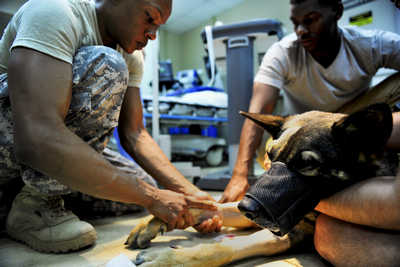
U.S. Army Sgt. 1st Class Kimberly Vaughn secures a needle into a military working dog before surgery on Camp Lemonnier, Djibouti, Nov. 15, 2014. The surgery was performed to remove a thick abscess from a severe insect sting that was not responsive to medication.
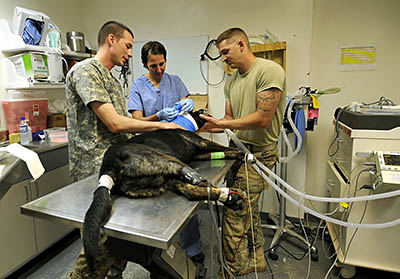
Bagram oh-toh-lar-ing-gol-uh-gist experiences dream of helping others
8/9/2013 - BAGRAM AIRFIELD, Afghanistan - Her specialty has also been used in the Army's veterinarian clinic here. When a dog has a problem with its ears, nose or mouth the vet calls Swartz. Thus far she has treated one military working dog on multiple occasions for perforated ear drum, ear infections and multiple hematomas in the dog's ear as a result from trauma causing the dog's ear to be drained to prevent infection and ear deformity.
Read More...
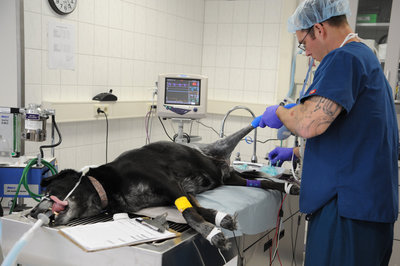
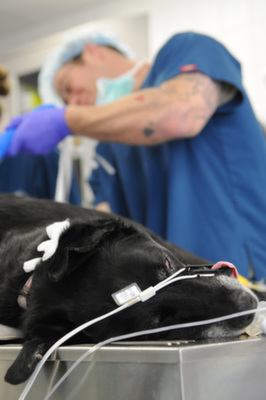
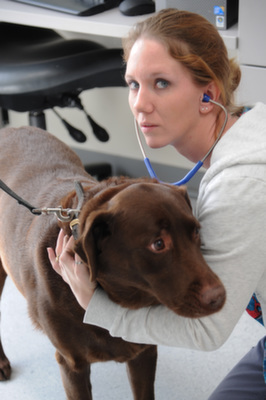
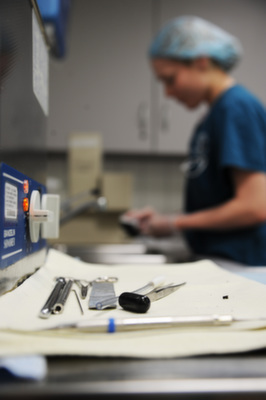
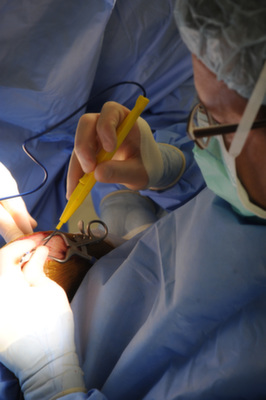
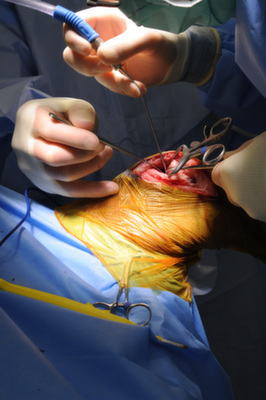
Two paws up for the vet clinic
6/14/2013 - RAMSTEIN AIR BASE, Germany -- Taking care of those four-legged family members is what the Public Health Command District-Northern Europe, Dog Center Europe, vet clinic on Pulaski Barracks does best.
"We have 19 different veterinary clinics throughout the region," said Army Maj. Kent Vince, Dog Center Europe director. "We also serve as a referral hospital for any dogs coming from the Central Command and Africa Command areas of operation, so we routinely receive injured military working dogs from Afghanistan and the Middle East."
The surgical department provides a variety of surgical procedures for the military working dogs.
Read More...
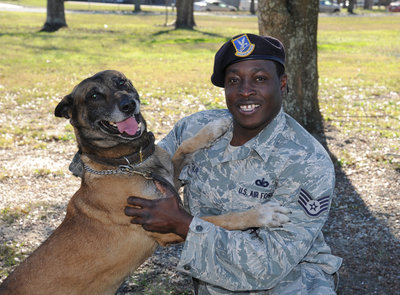
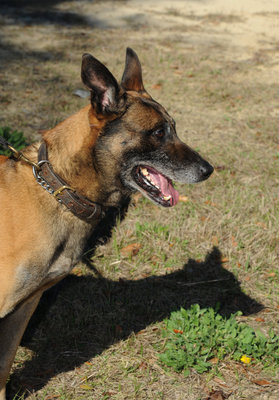
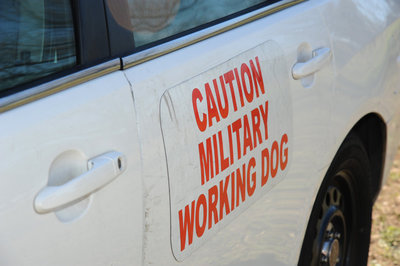
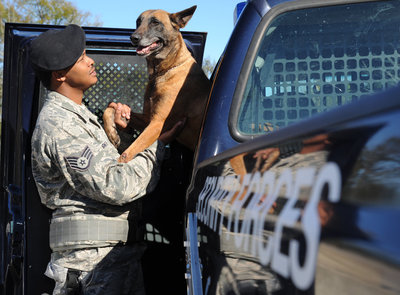
Like humans, dogs can suffer from PTSD
2/26/2013 - KEESLER AIR FORCE BASE, Miss. -- When Staff Sgt. Jay Martin was shot during his 2010 deployment, his partner stayed at his side during the medevac flight to a trauma unit. When Staff Sgt. Garth St. Clair carried his partner out of a building after an explosion in 2011, it wasn't immediately evident that his partner was deaf - he just had a limp from a leg injury as he kept scouring the area for improvised explosive devices. Tech. Sgt. Christopher Jarrell and his partner were pinned down side by side during a three-hour firefight with Taliban troops in 2011.
The partners of these 81st Security Forces Squadron members who deployed to Afghanistan had four legs, a tail and symptoms of what is being referred to as canine post-traumatic stress disorder. Military working dogs exposed to gunfire, explosions and other combat-related violence sometimes exhibit troubling behavior.
Read More...
